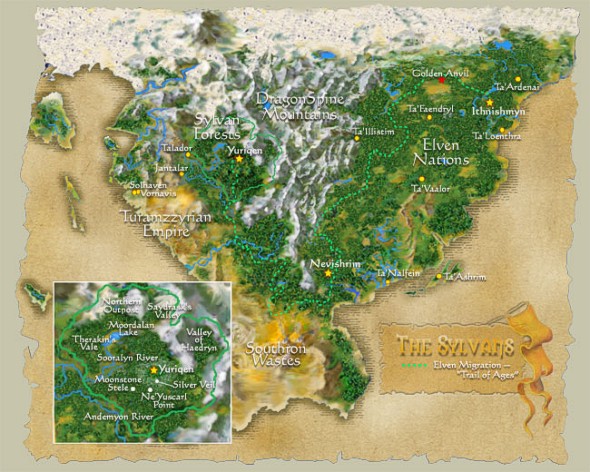|
The History of the Sylvan Elves
Early History (Approximately ca. -130,000
to ca. -60,000)
<< PREVIOUS
• History
of the Sylvan Elves • NEXT >>

In the earliest of days, a vast forest covered most of the lands between
the DragonSpine Mountains and the eastern coast of the continent.
Within the forests off the eastern seaboard dwelt the race of elves.
They were, from the first, an ingenious people and quickly learned
to fashion hide dwellings suspended from the trees. These were easily
disassembled to accommodate a nomadic lifestyle, a lifestyle that
was designed to conceal their colonies from the threat of the colossal
drakes that sailed the wide skies above the canopy of trees.
As time passed, the primitive tent-dwellings evolved into semi-permanent
constructions that featured some rock walls and hearths, but retained
the hide ceilings and upper walls of their earlier design. The people
learned first to adorn the hides of their dwellings with painted
symbols, and then to make pottery to contain food and water. They
domesticated a sturdy breed of antelope living in the forests, and
were soon moving their limited belongings via travois. As the colonies
grew in size, they divided into smaller groups for protection and
traveled the forests, always careful to conceal any evidence of
their movements. Their woodcraft skills increased, as well as their
survival abilities, with every generation.
With the advent of the Ur-Daemon Wars, the elves parted into smaller
bands and learned to move only in the darkness of night. Even so,
many perished. The ur-daemons learned to conceal themselves within
the forests and attack the drakes from below. Unsuspecting elves
would wander into a concealed monster and be devoured before they
realized their misfortune. Legends tell of invisible ur-daemons
suddenly coalescing out of the shadows of the trees and swallowing
whole elven families.
At the end of the darkness, as the ur-daemon menace was called,
the elven population was greatly diminished. However, Arkati aid,
chiefly from the goddesses Lumnis and Imaera, gave them a helping
hand. In clearings rent in the great forest by the battles between
drake and ur-daemon, the elves were shown how to grow crops that
would feed them through the cold seasons. With the ancient menace
of the drakes at an end, they embraced agriculture. Soon most colonies
had abandoned a nomadic lifestyle, staying in one region to tend
quickly expanding croplands. The elves soon moved from utilizing
available clearings, to felling trees on their own in order to expand
the cultivatable fields, and colonies grew as land-holdings grew.
The graceful tent-dwellings of the past evolved first into timber
structures, and then into those built of stone and brick.
Some elves held to the old ways, resisting the invitation to join
their brethren in the burgeoning towns. These disparate groups gradually
joined into one colony, disdaining all 'hard buildings' in favor
of old-style hide dwellings, and retaining only those possessions
that could be easily carried from place to place. The colony became
more reclusive, retiring into the depths of the ancient wood where
no direct sunlight could reach the forest floor. They remained closely
allied to Imaera, and out of that association a religion emerged
that had as a basic tenet the belief that they must resist the temptations
of the civilized tribes. And in the towns, the word sylvisterai
became a common term that referred to the reticent offshoot of elves,
meaning 'one who embraces -- or marries -- the forest.' And so,
the designation sylvan was born.
As the elven hamlets expanded and divided, seven houses emerged
as centers of power and around these grew towns that quickly evolved
into cities. Written history emerged, and a great library was raised
to house it. It was not long before other elven cities followed
the example set by Ta'Illistim. Trade was brisk between the cities;
however, in the forest, the sylvans discouraged visits from outsiders
by any means they could concoct short of outright churlishness.
Trade with their elven cousins was both discouraged and limited.
And since rarity in most cases breeds desire, the fine sylvan styled
bows, jewelry, leather goods and other handicrafts gained great
value among the seven cities.
Emissaries were routinely sent from each of the cities, bearing
invitations to the sylvans to settle within the boundaries of their
respective city, with promises of wealth and luxury. The sylvans
received each contingent with cool courtesy. However, the answer
was always the same. And as pressure to join a political family
grew, so did the sylvans' uneasiness.
|



